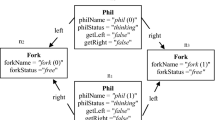Abstract
Evolutionary Testing (ET) has been shown to be very successful for testing real world applications [10]. The original ET approach focuses on searching for a high coverage of the test object by generating separate inputs for single function calls.
We have identified a large set of real world application for which this approach does not perform well because only sequential calls of the tested function can reach a high structural coverage (white box test) or can check functional behavior (black box tests). Especially, control software which is responsible for controlling and constraining a system cannot be tested successfully with ET. Such software is characterized by storing internal data during a sequence of calls.
In this paper we present the Evolutionary Sequence Testing approach for white box and black box tests. For automatic sequence testing, a fitness function for the application of ET will be introduced, which allows the optimization of input sequences that reach a high coverage of the software under test. The authors also present a new compact description for the generation of real-world input sequences for functional testing. A set of objective functions to evaluate the test output of systems under test have been developed. These approaches are currently used for the structural and safety testing of car control systems.
Access this chapter
Tax calculation will be finalised at checkout
Purchases are for personal use only
Preview
Unable to display preview. Download preview PDF.
Similar content being viewed by others
References
Baresel, A., Sthamer, H., Schmidt, M.: Fitness Function Design to improve Evolutionary Structural Testing. Proceedings of GECCO2002, New York, USA, pp. 1329–1336, 2002.
Beizer, B.: Software Testing Techniques. New York: Van Nostrand Reinhold, 1983.
Conrad, M., Hötzer, D.: Selective Integration of Formal Methods in the Development of Electronic Control Units. Proceedings of Second IEEE International Conference on Formal Engineering Methods ICFEM’98, IEEE Computer Society, pp. 144–155, 1998.
Harman, M., Hu, L., Munro, M., Zhang, X.: Side-Effect Removal Transformation. IEEE International Workshop on Program Comprehension (IWPC) Toronto, Canada, 2001.
Jones, B.-F., Sthamer, H., Eyres, D.: Automatic structural testing using genetic algorithms. Software Engineering Journal, vol. 11, no. 5, pp. 299–306, 1996.
Korel, B.: Automated Test Data Generation. IEEE Transactions on Software Engineering, vol. 16 no. 8, pp. 870–879, 1990.
Pohlheim, H.: GEATbx-Genetic and Evolutionary Algorithm Toolbox for Matlab. http://www.geatbx.com/, 1994–2003.
Sthamer, H.: The Automatic Generation of Software Test Data Using Genetic Algorithms. PhD Thesis, University of Glamorgan, Pontyprid, Wales, Great Britain, 1996.
Tracey, N., Clark, J., Mander, K., McDermid, J.: An Automated Framework for Structural Test-Data Generation. Proceedings of the 13th IEEE Conference on Automated SE, Hawaii, USA, 1998.
Wegener, J., Sthamer, H., Baresel, A.: Evolutionary Test Environment for Automatic Structural Testing. Special Issue of Information and Software Technology, vol. 43, pp. 851–854, 2001.
Wegener, J., Sthamer, H., Jones, B., Eyres, D.: Testing Real-time Systems using Genetic Algorithms. Software Quality Journal, vol. 6, no. 2, pp. 127–135, 1997.
Author information
Authors and Affiliations
Editor information
Editors and Affiliations
Rights and permissions
Copyright information
© 2003 Springer-Verlag Berlin Heidelberg
About this paper
Cite this paper
Baresel, A., Pohlheim, H., Sadeghipour, S. (2003). Structural and Functional Sequence Test of Dynamic and State-Based Software with Evolutionary Algorithms. In: Cantú-Paz, E., et al. Genetic and Evolutionary Computation — GECCO 2003. GECCO 2003. Lecture Notes in Computer Science, vol 2724. Springer, Berlin, Heidelberg. https://doi.org/10.1007/3-540-45110-2_147
Download citation
DOI: https://doi.org/10.1007/3-540-45110-2_147
Published:
Publisher Name: Springer, Berlin, Heidelberg
Print ISBN: 978-3-540-40603-7
Online ISBN: 978-3-540-45110-5
eBook Packages: Springer Book Archive




